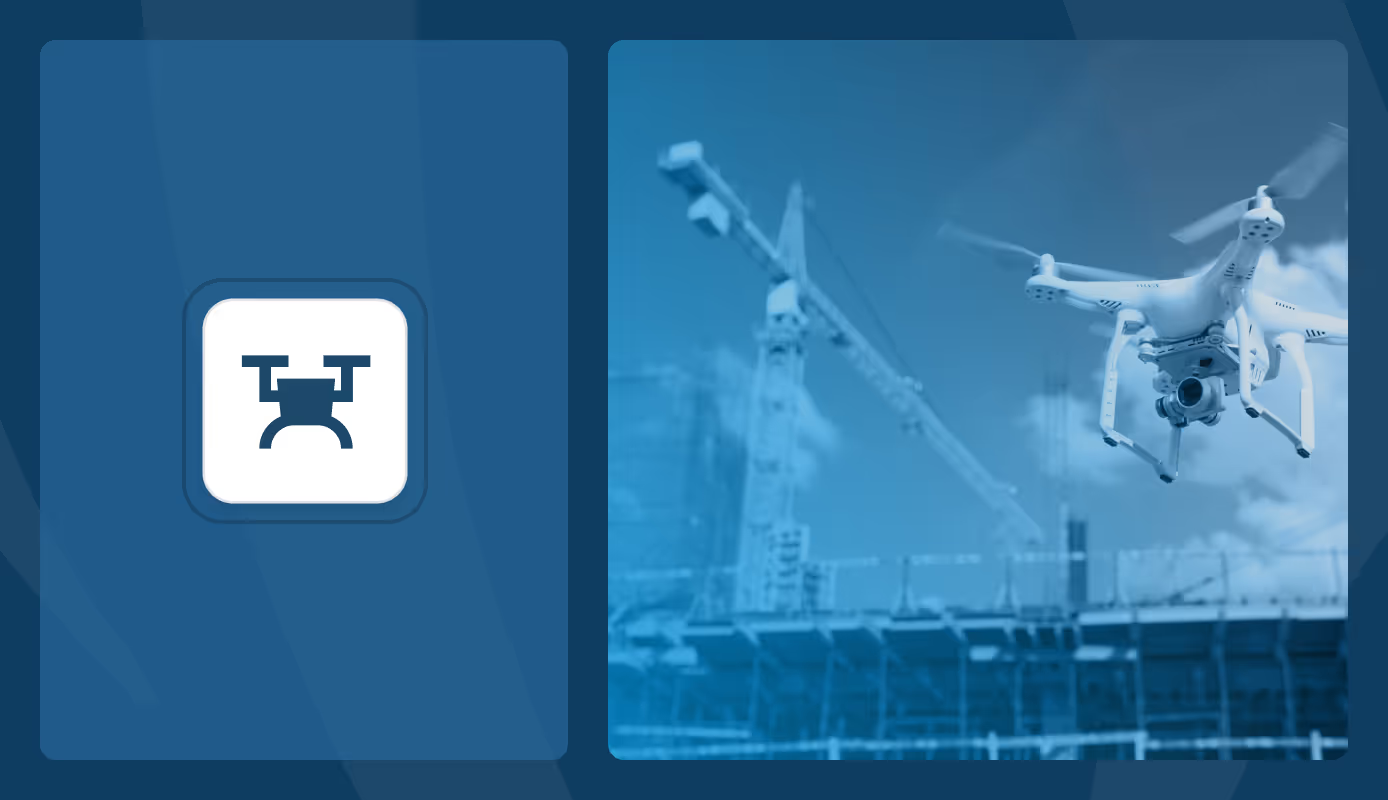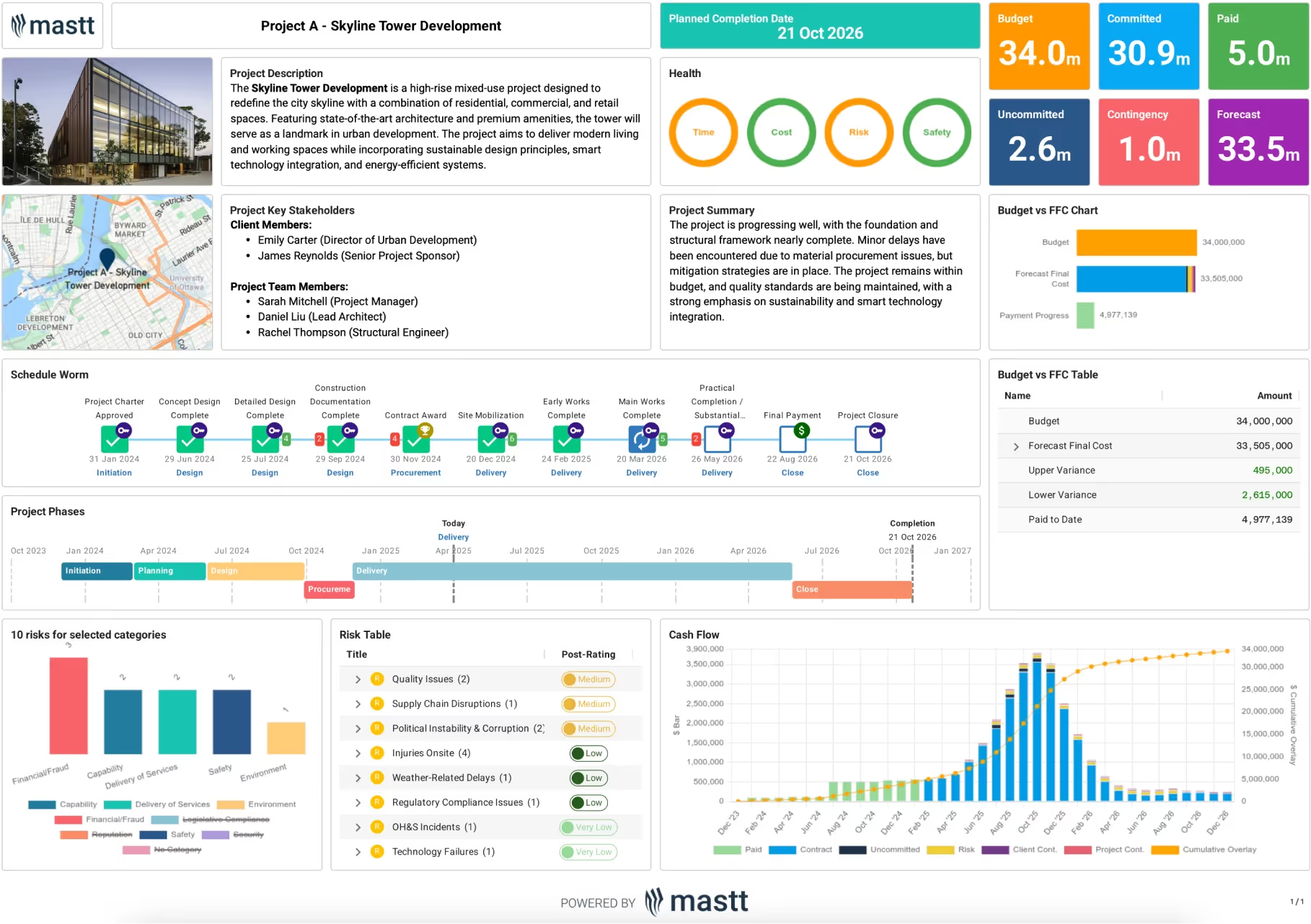Construction technologies are moving at full speed in 2025. From artificial intelligence and robotics to sustainable building methods, the industry is adopting tools that make projects smarter, safer, and more efficient.
In this article, you’ll discover the top emerging construction technologies shaping 2025. You’ll learn how each new construction technology works, explore real-world examples from the industry, and see why adopting them now is critical for staying competitive.
1. AI in Construction Project Management
Artificial Intelligence in construction project management is one of the fastest-growing construction technologies, using data-driven systems to improve planning and decision-making. It works by analyzing project information, spotting patterns, and offering predictions that help project managers act early.
AI improves efficiency by reducing errors and automating routine tasks. It also enhances scheduling and cost control, making projects more manageable.
Here are some ways AI is already being applied in construction project management:
- Data Processing Systems: Transform raw project data into structured formats for analysis.
- Pattern Recognition Models: Detect recurring trends in cost, scheduling, and performance data.
- Predictive Modeling Engines: Simulate project scenarios to forecast risks or delays.
- Natural Language Processing Tools: Extract and organize information from contracts, notes, and reports.
- Automated Scheduling Algorithms: Generate and adjust project timelines as inputs change.
- Resource Optimization Modules: Calculate efficient allocation of labor, equipment, and materials.
- Document Classification Systems: Categorize and tag files for fast retrieval and compliance.
- AI Agents for Task Automation: Act as digital assistants to handle reporting, payment reviews, and repetitive administrative tasks.
Not far from now, AI will connect more deeply with tools like BIM and digital twins. It promises smarter, data-driven projects where managers work proactively instead of reactively.
Real-World Example: Construction project management software like Mastt already shows how AI can simplify project delivery. With AI features like smart data entry and AI agents, project managers can streamline reporting and cut administrative workload.
2. Digital Twins with Real-Time Data
Digital twins are virtual replicas of physical assets, updated continuously with real-time data. They allow project teams to see how a building or infrastructure behaves before, during, and after construction.
By mirroring the physical world, digital twins make it easier to detect issues early and test solutions safely. They also support better planning, reducing delays and costly mistakes on site.
Some practical uses of digital twins in construction include:
- Data Integration Systems: Merge sensor inputs, BIM models, and project databases into one platform.
- Real-Time Synchronization: Continuously update models with live IoT and field data.
- Simulation Engines: Run scenario tests to predict asset behavior under varying conditions.
- 3D Visualization Interfaces: Generate interactive, navigable views of structures and systems.
- Predictive Analytics Models: Use historical and live data to anticipate maintenance or failure.
- Cloud-Based Platforms: Centralize twin data for multi-stakeholder collaboration and remote access.
- Lifecycle Tracking: Record performance data across design, construction, and operation phases.
In the near future, digital twins will become more integrated with IoT sensors, AI, and cloud-based platforms. This integration will allow projects to simulate performance and optimize operations long before issues appear on site.
Real-World Example: In Singapore, researchers created a Digital Urban Climate Twin to study how heat spreads across the city. The model allows policymakers to test solutions, such as adding green spaces or modifying building layouts to improve climate resilience.
3. BIM 7D and Cloud Collaboration
Building Information Modeling (BIM) 7D goes beyond 3D design by integrating cost, scheduling, and facility management data. When hosted in the cloud, it becomes a shared workspace where all stakeholders can access the same information.
This type of new construction technology transforms collaboration by keeping models accurate and accessible in real time. With BIM 7D and cloud collaboration, project teams can coordinate more effectively, reduce rework, and manage budgets with greater confidence.
BIM 7D and cloud collaboration enable:
- Multidimensional Modeling: Extend 3D designs with cost, scheduling, and facility data layers.
- Cloud-Based Hosting: Centralize models on shared platforms with real-time updates.
- Interconnected Data Models: Link design, construction, and operation data in one system.
- Automated Revision Tracking: Record and sync changes across disciplines automatically.
- Embedded Asset Information: Store specifications, equipment, and maintenance data inside the model.
- Role-Based Access Control: Manage permissions for different stakeholders.
- Lifecycle Data Management: Retain project data across design, construction, and operations.
Looking ahead, BIM 7D is set to become a cornerstone of modern project delivery. By pairing detailed modeling with cloud collaboration, it supports smarter planning and long-term asset management across the construction lifecycle.
Real-World Example: A Brunel University study in Kuwait found that integrating BIM 7D with sustainability data improves resource use and energy efficiency. The research showed that embedding facility management data early helps reduce waste and supports long-term sustainable construction practices.
4. IoT and Smart Site Monitoring
The Internet of Things (IoT) connects sensors, equipment, and devices across construction sites to deliver live data. This network gives managers instant insight into site conditions, resource utilization, and safety risks.
Smart monitoring helps flag potential issues before they escalate. Teams can track progress, improve safety, and make decisions based on real data, not guesswork.
IoT and smart site monitoring are being used to:
- Sensor Networks: Deploy devices on equipment, structures, and workers to capture live data.
- Wireless Communication Protocols: Transmit data via Wi-Fi, cellular, or low-power wide-area networks.
- Centralized Data Platforms: Aggregate inputs into dashboards for unified monitoring.
- Wearable IoT Devices: Capture worker movement, biometrics, and location onsite.
- Environmental Monitoring Systems: Measure factors such as dust, noise, temperature, and vibration.
- Edge Processing Units: Filter and process sensor data directly at collection points.
- Automated Alert Systems: Trigger real-time notifications when thresholds or anomalies are detected.
As construction becomes more connected, IoT will increasingly underpin smarter sites. By tying together machines, materials, and people, it fosters safer, more efficient construction environments.
Real-World Example: A study on smart monitoring tested IoT sensors with 3D laser scanning and ultra-wideband positioning on a residential construction site. Over 17 days, the system predicted concrete strength within 1-2 MPa accuracy. It also tracked worker locations with 1.4-meter precision, showing how IoT can improve both quality control and safety.
5. Automation and Robotics On-Site
Automation and robotics are among the most impactful construction technologies transforming how physical work is carried out on sites. From bricklaying robots to autonomous vehicles, these machines handle repetitive or high-risk tasks with speed and precision.
By taking over labor-intensive work, robotics reduces safety risks and frees up workers for more skilled activities. They also help keep projects on schedule by maintaining consistent productivity, even in tough site conditions.
Automation and robotics are being used to:
- Robotic Arms for Repetitive Tasks: Perform programmed actions such as bricklaying and welding.
- Autonomous Construction Vehicles: Navigate sites using GPS, LiDAR, and onboard sensors.
- Computer Vision Guidance: Identify objects, obstacles, and site conditions for precise movement.
- Remote Teleoperation Systems: Allow operators to control machinery through cameras and haptic feedback.
- Machine Learning Optimization: Refine robotic performance by analyzing real-time and historical data.
- Collaborative Safety Sensors: Enable cobots to detect proximity and work safely with humans.
In the years ahead, robotics will play a larger role in complex construction activities. Their integration with digital systems shows how new contech is driving faster, safer, and more precise building processes.
Real-World Example: On Japan’s Central Shinkansen project, researchers tested an autonomous excavator prototype that uses AI to predict penetration resistance. The system improved excavation efficiency and cut CO₂ emissions by nearly half, showing how robotics can advance both productivity and sustainability on complex sites.
6. Sustainable and Low-Carbon Technologies
Sustainable and low-carbon technologies aim to reduce the environmental impact of construction. These new construction techniques focus on cutting emissions, minimizing waste, and using materials that are more energy-efficient or recyclable.
Sustainable and low-carbon innovations are helping construction move toward greener practices without sacrificing quality or performance. They also address growing pressure from clients and regulators to deliver projects that meet sustainability goals.
Practical applications of sustainable and low-carbon technologies include:
- Carbon Capture Concrete: Injects captured CO₂ into concrete mixes during curing.
- Recycled Steel Production: Reuses scrap material in furnaces to cut emissions from new steelmaking.
- Prefabricated Modular Systems: Manufacture building components off-site to reduce on-site waste.
- Cross-Laminated Timber (CLT): Layers wood planks at right angles to create strong, low-carbon panels.
- On-Site Renewable Energy Systems: Install solar or wind units to power equipment and temporary facilities.
- High-Performance Insulation: Uses advanced materials to limit heat transfer and improve efficiency.
- Digital Carbon Tracking Tools: Monitor and record embodied carbon across construction stages.
Looking forward, sustainable and low-carbon solutions are set to become central to construction practices. Their adoption signals a future where construction is both innovative and environmentally responsible.
Real-World Example: The City of Portland piloted low-carbon concrete mixes in sidewalks, retaining walls, and playground infrastructure. The project tested how these mixes perform in real conditions while reducing embodied carbon in construction materials.
7. Extended Reality (AR/VR) for Training & Coordination
Extended reality (XR), which includes augmented reality (AR) and virtual reality (VR), is changing how construction teams learn and collaborate. These construction technologies create immersive environments where workers can practice tasks, explore designs, and visualize projects in real time.
By simulating jobsite conditions, XR improves safety training and reduces the risk of costly errors. It also enhances coordination by allowing stakeholders to walk through digital models before construction begins, spotting issues early.
Key applications of AR/VR in construction include:
- Head-Mounted Displays: Deliver immersive 3D visuals directly to users for training or walkthroughs.
- AR Overlays: Project digital instructions or models onto physical jobsite environments.
- 3D Model Integration: Import BIM or CAD files into virtual spaces for interactive use.
- Motion Tracking Systems: Capture user movement to enable realistic interaction in simulations.
- Haptic Feedback Devices: Provide tactile responses during virtual tasks for hands-on practice.
- Remote VR Collaboration Platforms: Allow teams to meet and review models in shared virtual spaces.
The growing use of XR reflects broader construction innovations that are reshaping how knowledge is shared across project teams. With immersive tools becoming more affordable, training and coordination are set to become faster, safer, and more engaging.
Real-World Example: A study on metro construction safety found that AR-based training improved worker understanding of risks compared to traditional slide-based methods. Trainees using AR identified hazards more effectively and responded with greater accuracy, showing the value of immersive learning in construction safety.
Challenges in Embracing New Technology in Construction
The biggest challenges in embracing new construction technologies are high costs, resistance to change, and integration issues. Many companies struggle to balance innovation with budget limits, workforce readiness, and existing systems.
These challenges don’t stop innovation but often delay it. Some platforms, like Mastt, are designed to be easier to integrate, helping reduce disruption and making adoption more straightforward for project teams. With better training, clearer strategies, and affordable solutions, adoption will grow steadily across the industry.
Benefits and Drawbacks of Using New Technologies in Construction
New technologies in construction can boost efficiency, improve accuracy, and strengthen project outcomes. At the same time, they may introduce cost, reliability, and security concerns that affect overall performance.
The table below highlights the key pros and cons of construction technology:
When used correctly, these innovations in the construction industry give project owners and managers stronger control over budgets, risks, and reporting. Still, successful adoption relies on proper training, phased implementation, and secure integrations so the tools deliver lasting benefits across capital projects.
Why Now is the Time to Adopt Construction Technologies
Adopting emerging construction technologies has become essential as the industry accelerates and expectations rise. Firms that move early gain an edge by boosting efficiency, staying competitive, and positioning themselves as leaders in a changing market.
The most important reasons to embrace new construction technology today are:
- Competitive Advantage: Firms adopting technology now win more projects by demonstrating advanced tools and modern methods.
- Operational Efficiency: Digital tools reduce delays, minimize rework, and streamline administrative tasks, keeping projects on track.
- Workplace Safety: Automation and smart monitoring systems reduce risks, protecting workers and preventing costly accidents.
- Sustainable Construction: Low-carbon materials and digital tracking help firms meet rising environmental and regulatory demands.
- Future Readiness: Early adoption prepares firms for new standards, client expectations, and industry-wide digital transformation.
Across the construction industry, clients and regulators are already pushing for higher standards of transparency, sustainability, and efficiency. AI construction companies that act now position themselves to meet these demands, with AI in construction playing a growing role in project delivery.
Construction Tech Reshaping the Future of the Industry
Construction technology is reshaping innovation in the construction industry by setting new standards for how projects are built and managed. The focus is shifting from short-term delivery to long-term value, with efficiency, safety, and sustainability at the core.
This change is moving teams from fragmented processes to connected, data-driven ways of working. Those who adapt today will be better positioned to deliver projects that are smarter, safer, and more sustainable.












